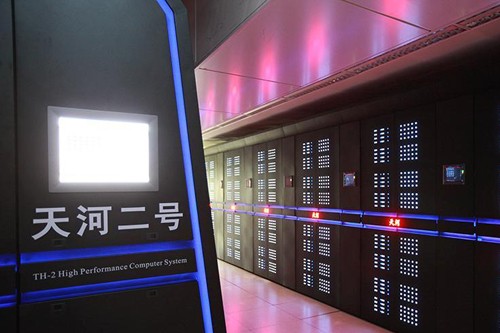China’s Tianhe-2 Ranked Fastest Supercomputer, Again; U.S. Systems ‘Nearing Historical Low’
| Michael A. Katz | | Nov 17, 2014 01:50 PM EST |
(Photo : National University of Defense Technology) Tianhe-2, developed by China's National University of Defense Technology, has been ranked as the world's fastest supercomputer for the fourth consecutive time.
Tianhe-2, the supercomputer developed by China's National University of Defense Technology, has been ranked as the world's fastest for the fourth consecutive time.
The Chinese supercomputer retained its position as the world's fastest system with a performance of 33.86 petaflop/s (quadrillions of calculations per second) on the Linpack benchmark, according to the 44th edition of the twice-yearly TOP500 list of the world's most powerful supercomputers.
Like Us on Facebook
This year's ranking remained little changed among the top-10 fastest supercomputer with the only new entry, a 3.57 petaflop/s Cray CS-Storm system installed at an undisclosed U.S. government site, coming in at number 10.
Despite being able to boast the world's fastest computer, China saw the number of its systems on the list decline to 61, compared to 76 in June 2014, the last time the rankings came out. Over the same period, Japan increased its number of systems from 30 to 32.
Although the U.S. is still home of the supercomputer with the most overall systems at 231, this is down from 233 in June 2014, and 265 on the November 2013 list. Top500 says that "The U.S. is nearing its historical low number on the list."
The number of European systems increased to 130, up from the 116 reported in last June's ranking, while the number of systems across Asia fell to 120 from 132.
The TOP500 list has been ranking the world's supercomputers since 1993, with the goal of providing a consistent measure of the performance growth of supercomputers. The group doesn't define "supercomputer," but uses a benchmark to rank systems and to decide if they qualify for the TOP500 list. All systems are ranked according to performance running the same Linpack benchmark application.
Performance Growth Slowing
In the most recent ranking, the overall growth rates of performance continues to be at historically low values for the last two years.
The TOP500 says that deceleration in average performance of all 500 systems is influenced by the very large systems at the top of the list.
"Recent installations of very large systems - up to June 2013 - have counteracted the reduced growth rate at the bottom of the list," the group said in a statement. "But with few new systems at the top of the past few lists, the overall growth rate is now slowing."
This is supported by the fact that the performance of the last system on the list has consistently lagged behind historical growth trends for the past five years. That rate is now at 55 percent a year; however, between 1994 and 2008 the annual growth rate for the No. 500 systems' performance was 90 percent.
Other Highlights
* Total combined performance of all 500 systems has grown to 309 Pflop/s, compared to 274 Pflop/s in June and 250 Pflop/s from one year ago.
* There are 50 systems with performance greater than 1 petaflop/s on the list, up from 37 six months ago.
* The No. 1 system, Tianhe-2, and the No. 7 system, Stampede, use Intel Xeon Phi processors to speed up their computational rate. The No. 2 system, Titan, and the No. 6 system, Piz Daint, use NVIDIA GPUs to accelerate computation.
* A total of 75 systems on the list use accelerator/co-processor technology, up from 62 last year. Of these, 50 use NVIDIA chips, three use ATI Radeon, and there are now 25 systems with Intel MIC technology (Xeon Phi).
* Intel continues to provide the processors for the largest share (85.8 percent) of TOP500 systems.
* HP has the lead in systems with 179 (36 percent) compared to IBM with 153 systems (30 percent).
TagsChina’s Tianhe-2 Ranked Fastest Supercomputer, Tianhe-2, TOP500 list, world’s most powerful supercomputers, HP, IBM Intel, National University of Defense Technology
©2015 Chinatopix All rights reserved. Do not reproduce without permission
 Chinese Students Win Patent for Urine-Powered Battery Charger
Chinese Students Win Patent for Urine-Powered Battery Charger Chinese Hackers Attack U.S. Weather Network, Congressman Accuses NOAA of Cover-Up
Chinese Hackers Attack U.S. Weather Network, Congressman Accuses NOAA of Cover-Up Move Over Moon, China Wants Mars
Move Over Moon, China Wants Mars- Xi Jinping: Proud Owner of World's First Dual-Screen Smartphone
 China Cracks Down on Spam with $5,000 Fines for Unwanted Texts
China Cracks Down on Spam with $5,000 Fines for Unwanted Texts- How to Encrypt Messages on Any Website - Even Facebook, Twitter, Gmail
EDITOR'S PICKS
-

Did the Trump administration just announce plans for a trade war with ‘hostile’ China and Russia?
-

US Senate passes Taiwan travel bill slammed by China
-

As Yan Sihong’s family grieves, here are other Chinese students who went missing abroad. Some have never been found
-

Beijing blasts Western critics who ‘smear China’ with the term sharp power
-

China Envoy Seeks to Defuse Tensions With U.S. as a Trade War Brews
-

Singapore's Deputy PM Provides Bitcoin Vote of Confidence Amid China's Blanket Bans
-

China warns investors over risks in overseas virtual currency trading
-

Chinese government most trustworthy: survey
-

Kashima Antlers On Course For Back-To-Back Titles
MOST POPULAR
LATEST NEWS
Zhou Yongkang: China's Former Security Chief Sentenced to Life in Prison

China's former Chief of the Ministry of Public Security, Zhou Yongkang, has been given a life sentence after he was found guilty of abusing his office, bribery and deliberately ... Full Article
TRENDING STORY

China Pork Prices Expected to Stabilize As The Supplies Recover

Elephone P9000 Smartphone is now on Sale on Amazon India

There's a Big Chance Cliffhangers Won't Still Be Resolved When Grey's Anatomy Season 13 Returns

Supreme Court Ruled on Samsung vs Apple Dispute for Patent Infringement

Microsoft Surface Pro 5 Rumors and Release Date: What is the Latest?










